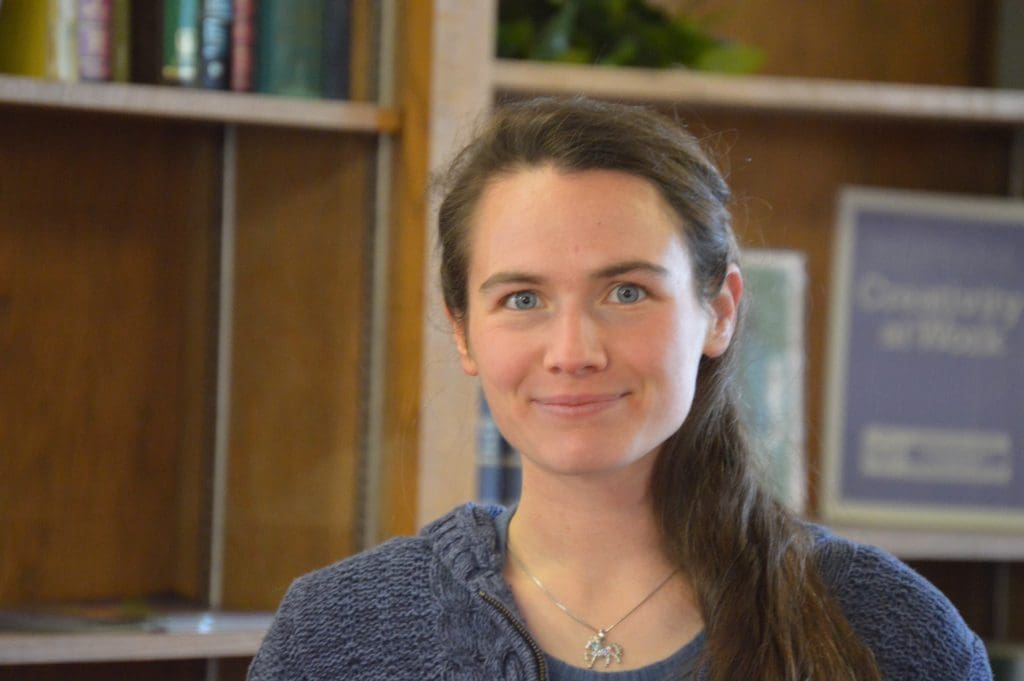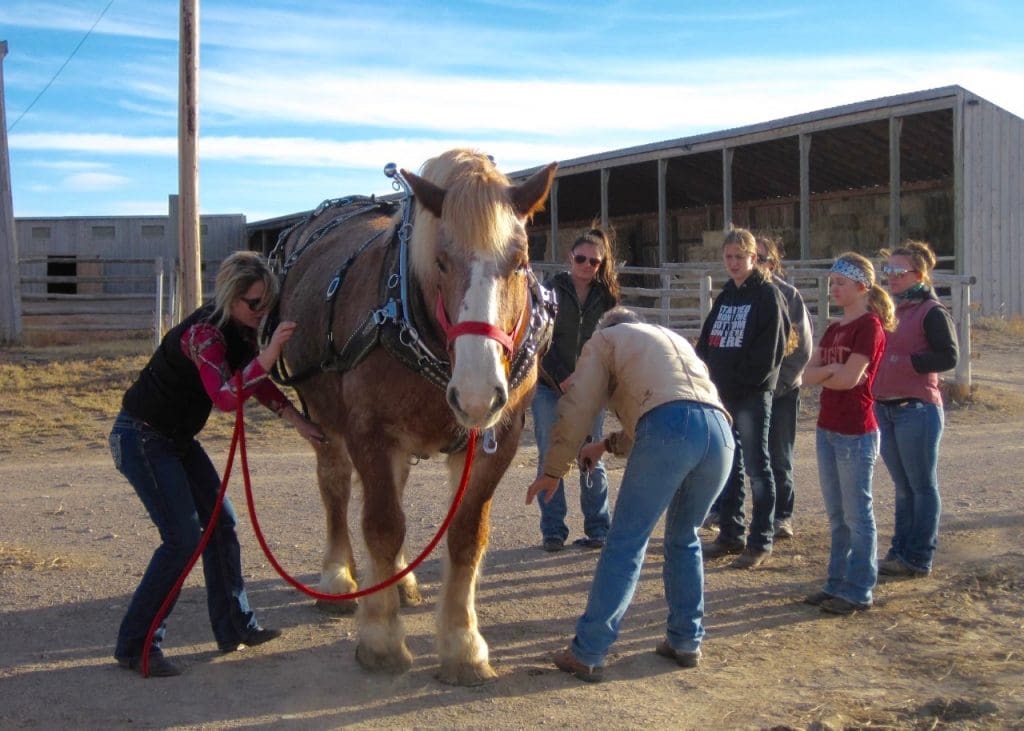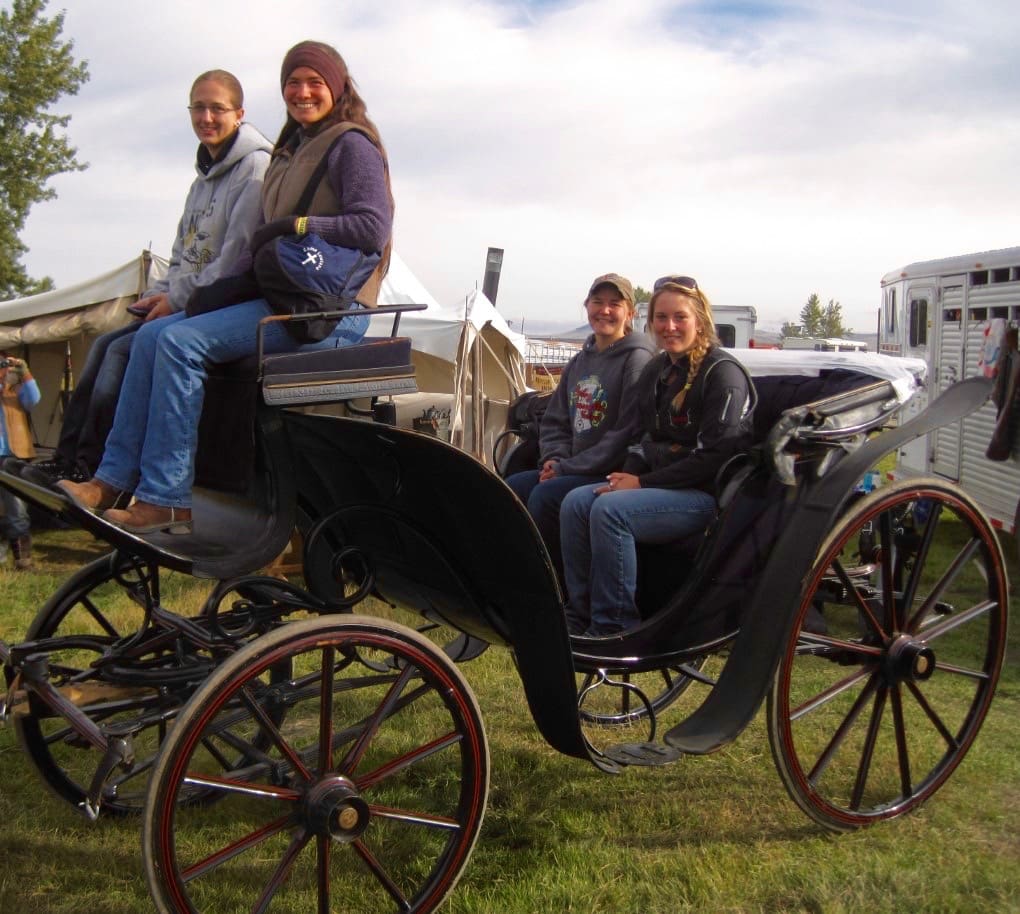December 19, 2016
The last event on Friday of the 2012 Idaho State Draft Horse and Mule International Show in Sandpoint, Idaho, had been the six-up.

By Montana Western graduate Lauren Bryan. Printed with permission from Draft Horse Journal.
The last event on Friday of the 2012 Idaho State Draft Horse and Mule International Show in Sandpoint, Idaho, had been the six-up. By the time Wade Thornley returned to the barn with his prancing hitch of chestnut Belgian geldings, Lydia, Katie, our college harness horsemanship class instructor Margaret Hebel and I had been working with Mr. Thornley and the Eagle Rock Belgians show hitch for about 24 hours as part of our class experience. As evening fell and the crowds dispersed for the night, we hustled with the Thornley family to stall the horses–unhitching from the wagon, leading the horses inside, wiping down harnesses, unraveling braids…
After four of the geldings had been brought into the barn, Margaret ushered me out to the wagon where Mr. Thornley sat, his wheel team still hitched to the wagon.
“Get up there beside him,” Margaret said, motioning to the seat.
I get to sit up there?! I scrambled up the side and slid onto the box seat, glancing around at the last people and dogs meandering past the closed concession stands. I waited for orders, wondering if Mr. Thornley was simply going to take me for a drive or if he needed assistance of some sort.
Then I noticed him offering the lines in my direction.
“What? Me?!”
He nodded, smiling.
I hesitated. I can’t do this! I’m not experienced enough to drive these horses! Apparently Mr. Thornley thought I was. I knew he would not be offering me this opportunity otherwise.
I took the lines.
Mr. Thornley said, “I’ll do the talking.” I nodded. He looked to the team. “Boys!” The chestnut geldings trotted off; I adjusted my lines, feeling for the horses’ mouths. We took an easy trot around the barn, the geldings obediently yielding to my gentle pulls and Mr. Thornley’s commands. By the time we reached the barn door again and I stepped off the wagon, my legs were trembling and a smile was plastered on my face for the rest of the evening. Katie and Lydia were the same after they drove; Margaret still teases us about our sappy grins whenever we take the lines of a horse.

My first introduction to the University of Montana Western’s harness horsemanship program came in the spring of my sophomore year when I took the Beginning Harness Horsemanship class taught by Margaret Hebel, a Teamster Hall of Fame inductee, with her three Belgian mares Carol, Nealy and Breezy. Since I was an Equine Studies student rather than a Natural Horsemanship major, all of my core horse classes at Montana Western were in the classroom only; thus, the driving course afforded me an opportunity to work hands-on with horses. Taking harness horsemanship horsemanship proved to be one of the most beneficial decisions I have made here at Montana Western, in more ways than one. I have learned that driving horses is an art–one which I now believe ought to be preserved for the benefit of future generations and one which, when properly learned and applied, positively enhances a person’s life and overall horsemanship.
In the beginner class, students spend their first weeks in the classroom learning about draft horse breeds, harness parts, general horsemanship and harnessing techniques. Once the students have grasped an understanding of the foundational information, they move outside to the arena where they practice catching, harnessing and unharnessing the drafts. By the third week in the arena, students are ground-driving the mares, learning how to use the proper cues (verbal and physical), developing confidence to drive through narrow openings, improving turning skills by weaving through serpentines and discovering the importance of line control and contact by pairing up with another person to drive a single horse (each student takes one line of the horse). About halfway through the semester, once Margaret is sure the students have a practical knowledge of the required skills, students learn how to harness and drive a team. By the end of the semester, students are hitching and driving teams with a wagon or forecart. Throughout the semester, in addition to the basic in-class instruction and practice, students participate in various field trips with the college’s Draft Horse Driving Club, thereby experiencing different vehicles, horse-handling methods and draft careers. Margaret tests the class with written tests, periodic quizzes, a final practical test, and summary/response papers to published articles.
However, more takes place in these weekly classes than just educational instruction. For myself and other students who do not have a horse at college, our Wednesday evenings with the horses refresh and rejuvenate us to endure another six days until the next class. For every student, the fresh air, the sweet scent of horse sweat, the clammy leather lines, the tug and give of the horse on the bit, that sense of “oneness” when horse and driver connect–all is practically life-giving. For three hours, these are the only things we have to think about. We can leave our rooms, textbooks, computers and headaches to simply be surrounded by life, nature, laughter, advice and encouragement.
By the time we finish class, wind-tossed and dusty, we are ready to conquer any of life’s obstacles, let alone our homework.
After such an uplifting semester, most of the students who pass the beginning level of harness horsemanship take the Advanced Harness Horsemanship class offered the following semester. In this second and last level, students practice more wagon and cart driving. In addition to improving their horsemanship skills, they especially focus on expanding their knowledge of various vehicle types and parts. The 2014 class, in which I was a student, was the first in recent years to attend the Sandpoint Show and help with the Eagle Rock Belgian hitch for the entire weekend. During the later fall months, when the evenings were too cold and miserable to drive, our small class–we only had three students that year–designed a board game applying much of the knowledge we had gleaned over the past two semesters. As in this case, Margaret regularly tries to tailor each course to what opportunities are available to us at the time; thus each class is unique, even though much of the basic information the students learn is the same.
At the end of the fall semester of my junior year, after completing the second-level class, I joined Montana Western’s Draft Horse Driving Club. Most harness horsemanship students do so in order to take advantage of draft horse opportunities and to stay engaged with other college students; that being said, all students on campus, even those without horse experience, are encouraged to join. Students that regularly participate in club activities for a year earn a work-ready vest embroidered with the words “10 ft Tall & Bulletproof,” emblematic of our harness horsemanship theme. The club is one of the most active on campus, having regular meetings twice a month and hosting various events throughout the year. Recognizing the value of community service, especially in a community which so strongly supports our college, we serve others by cleaning up the grandstands at the fairgrounds after the Labor Day Rodeo, volunteering at the Dillon Food Bank, anonymously providing 12 days’ worth of Christmas gifts to an underprivileged family, taking elementary school children for wagon rides during Heritage Days and donating money to support the agricultural endeavors of individuals in Third World countries. We also seize every opportunity for field trips–each fall we have been attending the Big Sky Draft Horse and Mule Expo in Deerlodge, Montana; last April we fed cattle with horses and sleds in sub-zero weather at the Castle Mountain Ranch in White Sulphur Springs, Montana; in the spring, the Bitterroot Driving Club invites us out to their spring drive in Western Montana; and one of the culminating events of the year is our trip to Colfax, Washington, to participate in the Plowing Bee.
One of the events our club is especially excited about this year is the upcoming Sandpoint Show in August. Now that we have helped there for two years, working with Eagle Rock Belgians and selling raffle tickets to audience members, we have been offered an incredible learning opportunity. Each student who attends will be paired up with a show hitch for the weekend; then, at some point during the show, each student will compete with his or her barn’s horses in a class specifically created for the Montana Western students. The college has even agreed to allow students to earn internship credits by working at Sandpoint and we are grateful to the show committee and the show hitches for affording us such an incredible opportunity that we would probably never be able to experience otherwise.

As wonderful as Montana Western’s harness horsemanship program is, it is not without its struggles. The club’s attendance varies, although it has been fairly consistent in recent years. Classes have been cancelled and at one point were nearly done away with entirely because of the lack of demand by students. However, this year, Margaret has a shocking total of 16 people in her class. The program is thriving, benefiting numerous students who will carry the knowledge of the draft horse industry with them as they graduate from UMW.
Truly, many students have already experienced the outstanding results of participating in the harness horsemanship program. For example, a few years ago one student obtained a job driving horses at Acadia National Park before she finished the second level class. Yet the results extend even beyond specifically harness horsemanship. When I interned at SPURS (Special People Using Riding Skills) Therapeutic Riding Center in South Dakota in 2015, the instructors were impressed enough with my horse-handling skills to trust me with schooling, exercising and testing horses. Due to the fact that I have had few riding opportunities during college, I know that driving horses is largely responsible for the level of horsemanship of which I am capable at this point.
So much more takes place in Montana Western’s Draft Horse program than just classroom education. As students and club members, we learn how to think and believe horses into action, how to take the time to understand each horse individually and how to work with other students as a team ourselves. The friendships developed in this program seem to be some of the strongest on campus, lasting even beyond graduation. As a current graduate myself, I know that the horse skills and life skills I have gained will last me as long as anything else I have been taught at UMW. I believe that fact holds true for all of the college students involved with the program–as we leave the University of Montana Western with our newfound understanding of the draft horse world, we leave ten feet tall and bulletproof with an eagerness to share with others the knowledge and experiences which have so positively impacted our own lives in a few short years.